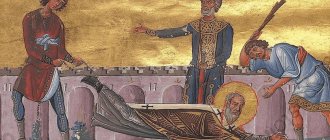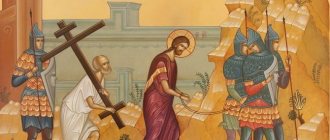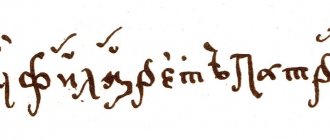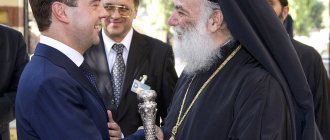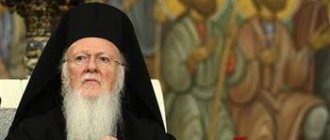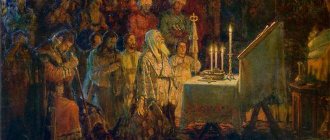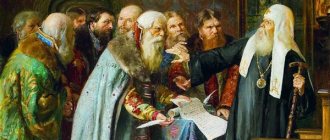| This article raises many issues. Please help | This article includes a list of general recommendations, but it remains largely untested because it lacks relevant inline quotes . |
| This biography of a living person requires additional quotes for verification . |
(Learn how and when to remove this message template)
Irenios Skopelitis
(born April 17, 1939) was the 140th patriarch of the Eastern Orthodox Patriarchate of Jerusalem from 2000 to 2005, although the dismissal was disputed.
Irenios was appointed locum tenens in 2000 and elected patriarch on August 13, 2001 of the Church of the Holy Sepulcher. He was enthroned on September 15, 2001 as "Patriarch of the Holy City of Jerusalem and all Palestine, Syria, beyond the Jordan River, Cana of Galilee and Holy Zion" in the presence of the highest ecclesiastical and secular dignitaries, including Archbishop Christodoulos of the Church of Greece and Metropolitan Nicholas of the Czech and Slovak Orthodox Church.
Disputes and dismissal
A few years later in the Irenai Patriarchate he was accused of selling several plots of church land in the Old City of Jerusalem to Israeli developers.
Since the majority of Orthodox Christians in the area are Palestinian, and the land was in an Arab-populated area that most Palestinians hoped would become part of a future Palestinian capital, these accusations caused great concern among Church members. On March 19, 2005, the Palestinian Authority formed a commission to investigate these allegations.
After a thorough investigation by the commission, the commission exonerated Patriarch Irineos and concluded that the charges brought against him were “a very well-thought-out plan... developed by a number of clerics opposed to Irineos in collaboration with the Israeli far-right wings. Their interests coincided. in order to gradually get rid of Ireneos." The report also concluded that "under the current legislation of East Jerusalem, Patriarch Irenaeus is still the legitimate Patriarch with full powers."[1]
Somewhat Orthodox Church Jerusalem leaders announced in a letter on May 5, 2005 that they had cut off contact (some called it a boycott) with Patriarch Irenaios and considered him removed from his position as Patriarch of Jerusalem.
The decision taken by the Holy Synod of Jerusalem of the Brotherhood of the Holy Sepulcher was made final on May 6, 2005 by a two-thirds vote of that body. As for the leaders of the Church, from that moment Irenaeus ceased to be a patriarch. May 24, 2005 in Constantinople (Istanbul) to review the decisions of the Holy Synod of Jerusalem. The pan-Orthodox conference, chaired by Ecumenical Patriarch Bartholomew, voted overwhelmingly to confirm the decision of the Brotherhood of the Holy Sepulcher and delete the name of Irenaeus from the diptych. On May 30, the Jerusalem Synod chose Metropolitan Cornelius of Petra to serve as locum tenens until a replacement for Irenaios was elected.
The Holy Synod of Jerusalem went even further. On June 16, 2005, it was announced that Irenaios had been demoted to the rank of monk.[2] This action is now widely seen as non-canonical. Ecumenical Patriarch Bartholomew also stated that defrocking has no legal force and is not recognized by any Orthodox Church. Since then, Irenios has not left his apartment and is de facto in custody there.[3]
Theophilus III was elected by the Synod on August 22, 2005 as the new patriarch. The elections were confirmed by the Pan-Orthodox Synod of Istanbul (Constantinople), and he was enthroned on November 22, 2005.
By long tradition, the removal of the Patriarch of Jerusalem and the election of his replacement requires the approval or recognition of the governments in the regions under the patriarchate's rule - currently Israel, the Palestinian Authority, and Jordan. Jordan acknowledged the dismissal by June 2005. Irineos continued to be recognized by Israel as the Orthodox Patriarch of Jerusalem until December 2007, and Israel continued to invite him to official government positions. As of December 20, 2007, the governments of Jordan, the Palestinian Authority, and Israel recognized Theophilus III as Orthodox Patriarch of Jerusalem.[4]
With Patriarch Irenaeus in the Holy Land
Bishop Jovan of Pakrack-Slavonia
December 28 is the fortieth day of the departure to the Lord of the Primate of the Serbian Orthodox Church, His Holiness Patriarch Irinej, an outstanding hierarch, theologian and pastor. The love for people, kindness and modesty of His Holiness remained in the memory and soul of everyone who had the opportunity to meet him. Among those who can share these happy memories is Bishop Jovan of Pakrack-Slavonia.
I met Patriarch Irenaeus for the first time in Hilandar [1], while still a novice. Metropolitan Amfilohije sent me and the current hieromonk M. to the Holy Mountain so that we could take a little breath after the “crushing” of the Cetinje Monastery during the war and “receive the Spirit.”
This happened immediately after the brief abbotship of Father Paisius (Tanasievich), when both the abbots and the brethren re-learned the communal order prescribed by Saint Sava, after centuries of idiorhythmia. Father Paisiy, after the extermination of his family on the Drina (repeatedly, for the same thing happened during the Second World War), retired to the recently restored monastery of St. Basil on the coast, where he received us with love and genuine Svyatogorsk hospitality. Soon he will go to Vranje (Southern Serbia), where in a short time he will create a number of brotherhoods and sisterhoods, which he, who died early, is still kept in grateful memory.
Patriarch Irenaeus - then Bishop of Nis - arrived in those days in Hilandar, where he was sent by the Holy Synod to lead the Liturgy at the monastery Glory of the Entry of the Mother of God into the temple [2]. If only they had told me then that he, but already as the Patriarch, would send me as his vicar in 2014 to Hilandar to lead the celebration of the memory of St. Simeon the Myrrh-Streaming [3]!
Bishop Niš looked at the unremarkable novices (however, a remarkable novice is an oxymoron) who came up to take the blessing, and asked where we were from, after which he kindly and slightly formally said: “Well, we need monastic cadres.” True, the novices were already sufficiently obsessed with the Holy Mountain for such recruitment to make an impression on them. Later Fr. M. and I remembered for a long time that strange force, embraced by which we, like two mountain goats, climbed from Vatopedi to Hilandar, and only after a while we admitted to each other that we could not understand what was happening to that other one, where he was flying like crazy.
Later, I most often met Vladyka Irenaeus in Niš, mainly when the route lay on the Holy Mountain or Constantinople, or when Metropolitan Amphilochius came to visit him after the fire that destroyed the recently restored Niš Cathedral Church; or we came to visit the commander of the Third Army, which had as its direct consequence the introduction of the celebration of Glory, and then the priesthood in the army.
In the summer of 2003, the Church of the Resurrection was empty, and at the Holy Sepulcher, where you usually had no more than half a minute, you could spend hours in prayer. The anniversary of the monastery of St. Sava in the Judean Desert was approaching, and the then newly elected Patriarch of Jerusalem Irenaeus was extremely alarmed that because of the Intifada [4] (and to Mar Saba [5] we had to get through the Palestinian territories, to which we were not allowed Israelis: the siege of the Basilica of the Nativity in Bethlehem has just ended) no one from the Orthodox world will be able to come.
“We heard your desire, yours and the Patriarch’s, Bishop of Nish will come to you,” Metropolitan Amphilochius told me over the phone on behalf of the Synod.
“Great,” I say, “he speaks Greek, this will please the Patriarch.” Thank you from me and the Patriarch!
I looked at the calendar, the beginning of December; Saint Sava December 5/18 (Jerusalem Patriarchate adheres to the Julian style) - there is time before the guest arrives. I fell hard on Hebrew, I had to pass the third level.
– Father Jovan where are you? A Serbian bishop is looking for you [6], - I hear the voice of Bishop Aristarchus, chief secretary of the Holy Synod of the Jerusalem Patriarchate. “For mercy, December 10, what a Serbian bishop,” I think.
– Come to the Knight's Palace hotel, it's here!
- Okay, I'm coming!
I was lucky that at that time I lived in the Oscar Niemeyer building on Paris Square, a few hundred meters from the Jaffa Gate. I see Vladyka Nishsky sitting in the hotel lobby!
“Here, I arrived from Sinai,” he says and laughs.
Well, yes! He was in the monastery of St. Catherine on the holiday of December 8 and through the Sinai and Negev deserts he reached Jerusalem!
“Lord, Eminence, you need to rest, you have been shaking from Sinai for two days,” I tell him.
– Yes, but it’s inconvenient for me that the Patriarchate pays for such an expensive hotel for me. Do you know a more modest place?
“Oh, where should I take the bishop to hotels and hostels, do you have a heart,” I think to myself.
– You know, I live not far from the Old Town, there is a good room in this apartment. Is this right for you? – He silently takes the bag and goes.
“Here, on the right, according to legend, is the cemetery of Saladin’s soldiers,” I say on the way, as we walk to the building where I lived. I still took the bag from him. On the go, I call Shmuel Evyatar, advisor to the mayor Ehud Olmert on Christian issues, and the Ambassador of Yugoslavia Krinka Vidakovic-Petrov, Ari Livna, the chief of the Republika Srpska representative office in Jerusalem, and agree with Bishop Aristarchus about a reception with the Patriarch and subsequent services.
The Greeks simply do not believe that someone has arrived. “What do we care about the Intifada, until yesterday we were bombed by NATO,” I joke with Aristarchus.
For the next ten days, the future Patriarch and I had breakfast, lunch and dinner together, and walked around the holy places of Jerusalem, mostly on foot.
Military attaché Colonel Dzhurin and Alexander Petrov, a great literature connoisseur and poet (“One hundred percent Serbian and one hundred percent Russian!”, as he said about himself) took the then Bishop of Nis around Galilee and the north of the Holy Land. He consecrated the Slavic kolach [7] to Dzhurina on the eve of the feast of St. Nicholas, and for a long time we sat with Patriarch Irenaeus of Jerusalem and Bishop Aristarchus, and they complained that the Israeli authorities still do not recognize the newly elected Patriarch. (The Patriarch of Jerusalem must be recognized by the Palestinian Authority and the State of Israel; Israel recognized Irenaeus only in 2005, after which the Council replaced him for internal reasons - a warning to everyone about the significance and power of the Council).
There was also room for a cup of coffee, and more than one, with Shmuel and dear Bishop Theophan, who today is the liturgical pendulum of the Jerusalem Patriarchate and its warmest hospitality.
When Ariy Livne, on behalf of the Republika Srpska, prepared dinner for a guest from Niš in the city center, an exclamation awaited us at the entrance:
“God help me,” the elderly woman rushed towards him. – I am Perera, from Nis!
“And I am Bishop of Nish,” he answers, and the conversation flows on, long and warm, as if she is a Nish parishioner whom he has known all his life.
When we finally descended and along the Kidron Stream entered the monastery of St. Sava for the all-night vigil and Liturgy, Bishop of Nis was met by his old friend, Father Gregory from Valjevo, a Chilandar who came from the Holy Mountain to the Khozevit monastery, and from the Khozevit monastery Patriarch Diodorus took him to the Monastery of St. Sava, where until his death in 2009 he kept the tradition that there were always Serbs in Mar Sabi, and was the main liturgist and housekeeper of the monastery.
“Here is my friend from Jerusalem,” exclaimed the newly elected Patriarch of Serbia when I came up on January 22, 2010 to congratulate His Holiness and take a blessing.
“Now you must visit Jerusalem as Patriarch,” I tell him, “but this time too with me!”
According to ancient tradition, the primates of the Local Orthodox Churches, after their election, pay visits to the heads of other Local Churches, starting with Constantinople.
But that December 2003 visit to this earthly Jerusalem was his last.
Translation with abbreviations: Svetlana Luganskaya
Reference
Bishop Jovan of Pakrac-Slavonia graduated from the Faculty of Literature at the University of Zagreb and the Faculty of Theology from the University of Belgrade. In 1991 he came to the monastery as a novice of Savin. In 1992 he was transferred to the Cetinje Monastery, where on the eve of the Nativity of John the Baptist in 1993 he was tonsured a monk with the name John (Jovan). In 1997 he was appointed abbot of the Moračnik monastery on Lake Skadar. In 1998 he founded radio “Svetigora”, the first radio channel of the SOC. From 1993 to 2003 he taught literature, Serbian and Slovenian languages, history at the Theological Seminary of St. Peter of Cetinje. Since June 1999, he was in Kosovo in the monastery of the Peć Patriarchate as a coordinator of relations with the forces of KFOR and UNMIK, his activities were aimed at saving the shrines and the people; refugee protection; counting and identification of killed, wounded, kidnapped, expelled and refugees. Since 2003, he has been in Israel to study, under the temporary jurisdiction of the Jerusalem Orthodox Church. He entered the master's program at Yad Vashem, defended his dissertation on Holocaust studies. He served in a number of churches and monasteries of the Holy Land. In Israel, he gave lectures on the collapse of Yugoslavia and interethnic relations, and participated in the preparation and holding of conferences on the Kosovo issue in Israel.
On May 26, 2011, by the decision of the Holy Council of Bishops of the Serbian Orthodox Church, he was elected vicar of the Patriarch of Serbia with the title Liplyansky. By the decision of the Holy Council of Bishops in 2014, he was elected Bishop of Pakrack-Slavonia.
Bishop Jovan is also known in the Serbian Orthodox Church as a military paratrooper. In October 2002, he was included in the reserve composition of the 63rd Parachute Brigade, of which he is the confessor.
—————————————
[1] Hilandar is one of the Athos monasteries, located on the northeastern side of the peninsula. The monastery was founded in 1198 by the Serbian Archbishop Saint Sava and his father, the Serbian Prince Stefan Nemanja, who took monastic vows at the nearby Vatopedi Monastery. In the Svyatogorsk hierarchy, Hilandar occupies 4th place.
[2] Glory of the Cross is a Serbian custom, celebrating the day of the patron saint of a family, church, or monastery.
[3] The Monk Simeon the Myrrh-Streaming in the world was the great zupan (ruler) of Serbia, united most of the Serbian lands and achieved political independence for his country. At the age of 80, Stephen retired to Athos, where his son, Saint Sava, became famous for the holiness of his life. The Monk Simeon was a great ascetic and wise mentor of monks.
[4] Intifada – Arab liberation movement. Currently, the word “intifada” most often refers to the armed struggle of Palestinian Arabs against Israel.
[5] Mar Saba or Lavra of Saint Sava is a Greek Orthodox monastery located in the West Bank in the Judean Desert. The monastery was founded in 484 by the Monk Sava the Sanctified. The monastery is under the jurisdiction of the Jerusalem Orthodox Church.
[6] Father Jovan, where are you? The Serbian bishop is looking for you - English.
[7] Slavsky kolach is a festive bread baked in honor of the Serbian holiday of the Glory of the Cross and solemnly consecrated.
December 26, 2022 Source: Nin Magazine
Social media
Short link:
copied
Recommendations
- Report of the Palestinian Commission: Palestinian Commission to study the facts and reality of the so-called Baab al-Khalil and the Greek Orthodox Patriarchate.
- BBC News: Orthodox leader demoted to monk
- "Exiled Patriarch Behind Locked Doors in Jerusalem"
- Jerusalem Post: Court suspends recognition of Greek patriarch Archived 2011-09-17 on the Wayback Machine
- “THE VISIT OF THE ECUMENIAL PATRIARCH PATRIARCH OF JERUSALEM IRENAI.” Orthodox Christianity
. Moscow. March 23, 2022. Retrieved 2018-11-01.
